Utilization of Internet of Things and Wireless Sensor Networks for Sustainable Smallholder Agriculture
Abstract
:1. Introduction
- Whether IoT and WSN can also be used and potentially benefit smallholder farming
- Whether the immediate data needs of the smallholder farmer are addressed, and
- Which design and implementation issues need to be considered for IoT and WSN application in smallholder agriculture.
2. Characteristics of Smallholder Agriculture
- Social attitude;
- The use of resources and infrastructure;
- Awareness and preparedness;
- Productivity.
2.1. Social Attitude
2.2. Resource Usage and Infrastructure
2.3. Awareness and Preparedness
2.4. Low Productivity
3. Data Acquisition in Smallholder Agriculture
- Conventional data collection Interviews, focus group discussions, surveys, sample collections and observations, on-farm trials and yield measurements are the conventional primary data collection approaches used in agronomic research and projects [38,39,40]. These are techniques for which physical presence of the data collector is needed, and they demand high resource mobilization, especially human labor. Sample collection, on-farm trials, observations and measurements are used to collect physical data such as soil properties and fertility, crop condition and yield estimates, while interviews, focus group discussions and surveys can be used for socio-economic data collection. In general, these data collection techniques exhibit a number of challenges. (i) Prolonged collection period to capture precisely spatio-temporal variability [41]; (ii) non-traceability as most smallholders have little formal education and do not keep written records of parameters during farm work, leading to lack of evidence; (iii) data collection is considered intrusive and less-trusted by farmers as the activities are mostly non-participatory and thus less transparent [40]. Collected data may be biased due to misinformed collectors or the use of poor sampling schemes. This may result in incomplete data with quality problems, subsequently leading to incorrect conclusions. However, with careful and proper execution, conventional tools are crucial for calibration and other statistical analytic purposes [38]. Such data may also complement and/or validate secondary data used in decision-making systems.
- Remote sensing Recent research efforts have shown the potential of RS and GIS technologies for monitoring smallholder farms and filling data gaps [42,43]. RS uses space-borne and airborne systems and generates valuable data such as crop phenotype, growth stages and crop health issues, soil type, soil moisture and farm input uses [44]. The potential of RS to assess crop and soil properties, and farm inputs is demonstrated in [17,19,43,45,46]. The actual application of these tools is uncommon in developing countries. The lack of ground truth data, the high learning curve to understand and use the outcomes, the coarse spectral resolution as well as lack of appropriate training are reasons for their limited use. Small and fragmented farms, vegetation heterogeneity, and atmospheric conditions also diminish quality and usefulness of RS data [47,48]. Nonetheless, RS has high potential in complementing conventional data collection approaches and holds promise to assist sustainable farming practices.
- Proximal sensing A closer look at a farm field can be achieved with PS; sensors positioned approx. 2 m above the field surface then capture data [49]. A number of agricultural parameters including soil properties, crop growth metrics and farm inputs can be acquired through this platform [50,51].This is done by electromagnetic sensors, ground penetrating radar (GPR) and gamma-ray spectrometry sensors [15,47]. PS sensors are typically mounted on tractors, spreaders, sprayers or irrigation booms. PS technology is relatively economical, more accurate and offers higher spectral resolution than RS [52]. However, low temporal resolution, labor intensity and significant cost hinder full usability. The scarcity or absence of mechanized farming vehicles is another barrier to utilization of PS. A review of both RS and PS technology in soil data collection and associated challenges is provided in [53].
- In-field sensing IoT and WSN can complement the above approaches and help minimize their mentioned challenges. IoT is a platform through which objects can be interconnected to generate and exchange relevant and valuable information. Objects can be both physical and virtual. WSN is at the heart of this platform enabling reliable interaction between dispersedly located objects. IoT and WSN have application in the broader agricultural domain. Monitoring, tracking, automation, and precision agriculture can be mentioned in this context. Several projects are known in the developed world: the EU’s Food and Farm 2020 project, the Kansas water preservation through sensors, and NanoGanesh are a few examples [54]. The NanoGanesh project, for instance, is an irrigation automation system that creates mobile-based remote control for water pumps and water tanks using sensor information. The project helps farmers to control water pumps, their power supply, and provides vandalism alerts of field-deployed equipment. Other projects have designed affordable, all-inclusive farm improvement mechanisms that utilize IoT and WSNs [25,26,55,56]. Smallholder farmers require information and advice, down-scaled to the plot level, to improve their practice; stakeholders such as agricultural extension agents, and (non-)governmental aid organizations also rely on such information for planning. The point-level data offered through IoT and WSN makes the technology fitting with only a limited number of sensors per plot. Inexpensive sensors keep things affordable, also to smallholders. In addition, IoT and WSN are simple and quick approaches for farm-level data collection that allow direct interpretation. Further discussion of IoT and WSN is presented in Section 5.
4. Literature Search Methodology
5. IoT and WSN in Smallholder Agriculture
- Purpose;
- Sensor deployment and implementation;
- Communication technology;
- Power sources;
- Computing analysis;
- Quality assurance.
5.1. Purpose
5.2. Sensor Deployment Schemes
5.3. Data Communication Approaches
5.4. Energy Sources and Saving
5.5. Computational Analysis
- Data acquisition This entails the process of what and how data are being collected. In IoT and WSN set-ups, the data acquisition layer focuses on parameter identification, device selection and set-up, communication network selection and establishment, and the data collection phase itself. The sensing and control layers discussed in Section 5 are mapped to this stage of data science.
- Data curation In this phase, data cleaning and pre-processing of acquired sensor data are conducted to improve its reliability. Important tasks are filtering, adding, dropping and transferring. It also handles integration of data from different sensors, through well-defined data mapping algorithms. The heterogeneity of devices, operating platforms and absence of de facto communication standards in IoT and WSN communication often obstruct direct and full utilization of the technology. The syntactic and semantic variations at hardware and software levels of the system pose interoperability and integration challenges [93]. Variation in data collection and representation, different communication specifications such as transmission rate and bandwidth, and data processing and presentation are issues to be addressed in this context. One of the critical functionality of a data curation is, thus, facilitation of such data integration. This phase is crucial as the remaining action chains are dependent on its outcome.
- Data processing and analysis The data processing and analysis phase is where computations are executed on the raw, sensor data acquired from farms. These computations can be classified into three general groups: (a) Simple, which is a threshold-based if-then analysis that determines incidents as deviations from pre-defined values; (b) Statistical, that determines standard statistics such as regressions and ANOVA; and (c) AI, which brings forecasting and prediction capabilities through advanced mathematical and machine learning computations, using artificial neural network (ANN), deep learning (DL) and other techniques. Operations executed in this phase are based on specific application needs and shall assist the decision-making of smallholder farms. It is responsible to produce usable knowledge from the pre-processed data passed to it.
- Information presentation and visualization The presentation and visualization phase handles the human–computer interaction (HCI) and defines appropriate information delivery mechanisms. It also handles the information presentation format prescribed as suitable by the end user. Three broad categories for presentation and data visualization are: web-based, application-based, and SMS- or alert-based. Web-based data presentation can reach users through a stand-alone web page or as social media feeds, such as tweets. The application-based information presentation uses a dedicated mobile application developed and installed on the user’s smartphone. Both web- and application-based mechanisms support graphical and textual data visualization options and provide multi-language access. They do require regular internet access and smart devices. The SMS information presentation is a text-based data delivery that runs on regular phones and can present short alert information to users on the farm status and actions advised.
- Computing environment This environment determines the computing capabilities used in all stages of data processing. Edge computing, cloud computing or private computing environments can be used in agriculture data processing. The choice of platform depends on the application needs and resource availability. In an IoT and WSN set-up for agriculture data processing, edge computing can be ideal to process and disseminate information to farmers in real-time. This is also advantageous especially when network communications are fragile, as can be the case in smallholder farming. Edge computing, however, may present challenges in deployment in resource-constrained devices such as sensor nodes and may set limits to data processing implementations. AI algorithms specifically need substantial computation, memory and power resources, which are usually scarce in a WSN. Edge computing also sets higher quality requirements to the software as it is harder to upgrade once deployed.Cloud computing offers rich resources to implement sophisticated and large data processing algorithms and persistent storage. It also facilitates the re-usability of open cloud solutions provided as software as a service (SaaS) or infrastructure as a service (IaaS). However, accessibility and network bandwidth demand is a concern in smallholder communities. A private server can be set up with equivalent resource provision to a cloud computing with self-built data analysis and presentation mechanisms.
- Quality assurance These are associated tasks that ensure overall data processing and information generation are of some expected quality standard and fit with user expectations. It is a rigorous task that needs to be present in every stage of data processing. During data acquisition, some QA measures can be device testing and calibration, and communication network reliability and efficiency validation. QA during the data curation and data processing phases can be validation of data by pre-processing algorithms in terms of reliability, efficiency and optimality. A dearth of accurate baseline data regarding different agriculture parameters challenges these tasks. Regardless, some quality assurance have to be in place to ensure sensor data are reliable before further investigation and decision support information generation. The computing environment also needs to meet required quality standards such as security, reliability and accessibility.
5.6. Quality Assurance
6. Discussion
7. Challenges
- High investment costs: The investments needed to produce and deploy a WSN and IoT system are significant, which may not be affordable by most projects. Hardware costs are those for gateway and sensor nodes, recurring IoT connection, and power provision, while open source tools exist, realistic deployments may need commercial cloud applications such as SAAS, which are a substantial cost factor.
- Little awareness: Stakeholders in the agri-chain typically have limited knowledge of recent technological innovations. This is a cause of resistance against acceptance of IoT and sensor technology.
- Low availability of tools and skilled personnel: Most IoT and WSN equipment are not produced in the developing countries. Operation and maintenance of devices may require considerable knowledge, language and professional skills. Such are often thin on the ground and this hinders full deployment and utilization.
- Regulatory and policy gaps: Telecommunications of many developing world countries have no clear regulatory arrangement of WSN and IoT implementations. The allowed Industrial Scientific and Medical (ISM) radio frequency range for WSN communication is not set yet and no other rules exist governing the use of frequency bandwidth. As a result, investments are risky because node communication may become blocked or interrupted.
- Poor interoperability: IoT and WSN have evolved rapidly over the past five years. A number of tools and platforms exist that can be used for the realization of the technology. There is however no standard yet that guarantees their interoperability.
- Low data quality: WSN deployment often comes with exposure to extreme physical conditions. This may cause reading faults and poor data quality. Sensor data reliability may also be compromised by deployment errors. Incorrect calibration, inconsistent power supply and unreliable communications can result in data errors such as outliers, drifts and missing values.
8. Conclusions
Funding
Conflicts of Interest
References
- Ricciardi, V.; Ramankutty, N.; Mehrabi, Z.; Jarvis, L.; Chookolingo, B. How much of the world’s food do smallholders produce? Glob. Food Secur. 2018, 17, 64–72. [Google Scholar] [CrossRef]
- International Labour Organization. Employment in Agriculture (% of Total Employment) (Modeled ILO Estimate) | Data; International Labour Organization: Geneva, Switzerland, 2017. [Google Scholar]
- FAO; IFAD; UNICEF; WFP; WHO. Food Security and Nutrition in the World the State of Building Climate Resilience for Food Security and Nutrition; Technical Report; FAO: Rome, Italy, 2018. [Google Scholar]
- World Food Program. World Food Programme in Ethiopia, Federal Democratic Republic of (ET); Technical Report; WFP: Rome, Italy, 2016. [Google Scholar]
- Lowder, S.K.; Sánchez, M.V.; Bertini, R. Which farms feed the world and has farmland become more concentrated? World Dev. 2021, 142, 105455. [Google Scholar] [CrossRef]
- FAO; IFAD; UNICEF; WFP; WHO. The State of Food Security and Nutrition in the World 2017—Building Resilience for Peace and Food Security; Technical Report; Food and Agriculture Organization of the United Nations: Rome, Italy, 2017. [Google Scholar]
- Rapsomanikis, G. The Economic Lives of Smallholder Farmers: An Analysis Based on Household Data from Nine Countries; Technical Report; Food and Agriculture Organization of the United Nations: Rome, Italy, 2015. [Google Scholar]
- Hanson, W.; Heeks, R. Impact of ICTs-in-Agriculture on Rural Resilience in Developing Countries; Working Paper Development Informatics 84; Centre for Development Informatics Global Development Institute, SEED: Vienna, Austria, 2020. [Google Scholar] [CrossRef]
- European Commission Development and Cooperation. Sustainable Agriculture for the Future We Want; Technical Report; European Commission: Brussels, Belgium, 2012. [Google Scholar]
- Kamilaris, A.; Kartakoullis, A.; Prenafeta-Boldú, F.X. A review on the practice of big data analysis in agriculture. Comput. Electron. Agric. 2017, 143, 23–37. [Google Scholar] [CrossRef]
- Ingram, J.; Maye, D. What Are the Implications of Digitalisation for Agricultural Knowledge? Front. Sustain. Food Syst. 2020, 4, 66. [Google Scholar] [CrossRef]
- Krall, S. What Is Sustainable Agriculture? Technical Report; Deutsche Gesellschaft für Internationale Zusammenarbeit (GIZ) GmbH: Bonn, Germany, 2015. [Google Scholar]
- Henrichs, E.; Noack, T.; Pinzon Piedrahita, A.M.P.; Salem, M.A.; Stolz, J.; Krupitzer, C. Can a Byte Improve Our Bite? An Analysis of Digital Twins in the Food Industry. Sensors 2021, 22, 115. [Google Scholar] [CrossRef] [PubMed]
- Keita, N.; Carfagna, E. Overview of methodological issues for research to improve agricultural statistics in developing countries. In Proceedings of the ICAS-V, Nice, France, 19–24 September 2010; pp. 1–26. [Google Scholar]
- Wulf, H.; Mulder, T.; Schaepman, M.E.; Jörg, P.C. Remote Sesing of Soils; University of Zurich: Zurich, Switzerland, 2014; pp. 1–71. [Google Scholar] [CrossRef]
- Zerger, A.; Rossel, R.V.; Swain, D.; Wark, T.; Handcock, R.N.; Doerr, V.; Bishop-Hurley, G.; Doerr, E.; Gibbons, P.; Lobsey, C. Environmental sensor networks for vegetation, animal and soil sciences. Int. J. Appl. Earth Obs. Geo-Inf. 2010, 12, 303–316. [Google Scholar] [CrossRef]
- Dabrowska-Zielinska, K.; Budzynska, M.; Gurdak, R.; Musial, J.; Malinska, A.; Gatkowska, M.; Bartold, M. Application of Sentinel-1 VH and VV and Sentinel-2 for soil moisture studies. In Proceedings of the Active and Passive Microwave Remote Sensing for Environmental Monitoring; Notarnicola, C., Pierdicca, N., Santi, E., Eds.; International Society for Optics and Photonics, SPIE: San Diego, CA, USA, 2017; Volume 10426, pp. 75–86. [Google Scholar] [CrossRef]
- Jain, M.; Mondal, P.; Galford, G.L.; Fiske, G.; DeFries, R.S. An automated approach to map winter cropped area of smallholder farms across large scales using MODIS imagery. Remote Sens. 2017, 9, 566. [Google Scholar] [CrossRef] [Green Version]
- Burzykowska, A.; Velasco, A.; Klaase, A.; Huber, S.; Geerders, P.; Dost, R.; Vrielink, A.; Haas, E.; Rolf, A.; Aparicio, E. How can Earth Observation support agriculture development in rural areas? EO4SD—Agriculture and Rural Development cluster. In A Better World; Tudor Rose: Leicester, UK, 2018; pp. 18–23. [Google Scholar]
- Rokhmana, C.A. The Potential of UAV-based Remote Sensing for Supporting Precision Agriculture in Indonesia. Procedia Environ. Sci. 2015, 24, 245–253. [Google Scholar] [CrossRef] [Green Version]
- Adão, T.; Hruška, J.; Pádua, L.; Bessa, J.; Peres, E.; Morais, R.; Sousa, J.J. Hyperspectral imaging: A review on UAV-based sensors, data processing and applications for agriculture and forestry. Remote Sens. 2017, 9, 1110. [Google Scholar] [CrossRef] [Green Version]
- Navarro, E.; Costa, N.; Pereira, A. A systematic review of IoT solutions for smart farming. Sensors 2020, 20, 4231. [Google Scholar] [CrossRef] [PubMed]
- Singh, V.; Sharma, N.; Singh, S. A review of imaging techniques for plant disease detection. Artif. Intell. Agric. 2020, 4, 229–242. [Google Scholar] [CrossRef]
- Dlodlo, N.; Kalezhi, J. The internet of things in agriculture for sustainable rural development. In Proceedings of the 2015 International Conference on Emerging Trends in Networks and Computer Communications (ETNCC), Windhoek, Namibia, 17–20 May 2015; p. 6. [Google Scholar] [CrossRef]
- Nachankar, P.J.; Somani, M.G.; Singh, D.M.; Katkar, S.N. IoT in Agriculture. Int. Res. J. Eng. Technol. 2018, 5, 592–596. [Google Scholar]
- Davcev, D.; Mitreski, K.; Trajkovic, S.; Nikolovski, V.; Koteli, N. IoT agriculture system based on LoRaWAN. In Proceedings of the 2018 14th IEEE International Workshop on Factory Communication Systems (WFCS), Imperia, Italy, 13–15 June 2018; pp. 1–4. [Google Scholar]
- Ojo, M.O.; Viola, I.; Baratta, M.; Giordano, S. Practical experiences of a smart livestock location monitoring system leveraging gnss, lorawan and cloud services. Sensors 2022, 22, 273. [Google Scholar] [CrossRef] [PubMed]
- Weldegiorges, Z.K. Benefits, Constraints and Adoption of Technologies Introduced through the Eco-Farm Project in Ethiopia. Master’s Thesis, Norwegian University of Life Sciences, Aas, Norway, 2014. [Google Scholar]
- Lowder, S.K.; Skoet, J.; Raney, T. The Number, Size, and Distribution of Farms, Smallholder Farms, and Family Farms Worldwide. World Dev. 2016, 87, 16–29. [Google Scholar] [CrossRef] [Green Version]
- Paul, M.; wa Gĩthĩnji, M. Small farms, smaller plots: Land size, fragmentation, and productivity in Ethiopia. J. Peasant Stud. 2018, 45, 757–775. [Google Scholar] [CrossRef]
- Co-operative, D.; Development, E. A Framework for the Development of Smallholder Farmers through Cooperative Development; Technical Report; Department of Agriculture Forestry and Fisheries: Pretoria, South Africa, 2012. [Google Scholar]
- Cao, H.; Li, Y.; Chen, G.; Chen, D.; Qu, H.; Ma, W. Identifying the limiting factors driving the winter wheat yield gap on smallholder farms by agronomic diagnosis in North China Plain. J. Integr. Agric. 2019, 18, 1701–1713. [Google Scholar] [CrossRef]
- Dutta, S.; Chakraborty, S.; Goswami, R.; Banerjee, H.; Majumdar, K.; Li, B.; Jat, M.L. Maize yield in smallholder agriculture system—An approach integrating socioeconomic and crop management factors. PLoS ONE 2020, 15, e0229100. [Google Scholar] [CrossRef] [PubMed]
- Cornejo-Velazquez, E.; Acevedo-Sandoval, O.A.; Romero-Trejo, H.; Toriz-Palacios, A. Low-cost Technological Strategies for Smallholders Sustainability: A Review. J. Technol. Manag. Innov. 2020, 15, 105–113. [Google Scholar] [CrossRef]
- Tambo, J.A.; Kansiime, M.K.; Mugambi, I.; Rwomushana, I.; Kenis, M.; Day, R.K.; Lamontagne-Godwin, J. Understanding smallholders’ responses to fall armyworm (Spodoptera Frugiperda) Invasion: Evid. Five African Countries. Sci. Total Environ. 2020, 740, 140015. [Google Scholar] [CrossRef] [PubMed]
- Clause, V.; Taverner, D.; Hayward, T. Space for Agriculture in Developing Countries; Technical Report; UK Space Agency International Partnerships Programme: Swindon, UK, 2018. [Google Scholar]
- Gaffney, J.; Challender, M.; Califf, K.; Harden, K. Building bridges between agribusiness innovation and smallholder farmers: A review. Glob. Food Secur. 2019, 20, 60–65. [Google Scholar] [CrossRef]
- Shibusawa, S.; Haché, C. Data Collection and Analysis Methods for Data from Field Experiments. In Systems Analysis and Modelling in Food and Agriculture; Ting, K., Fleisher, D.H., Rodriguez, L.F., Eds.; UNESCO-EOLSS: Oxford, UK, 2009; p. 29. [Google Scholar]
- Daum, T.; Buchwald, H.; Gerlicher, A.; Birner, R. Smartphone apps as a new method to collect data on smallholder farming systems in the digital age: A case study from Zambia. Comput. Electron. Agric. 2018, 153, 144–150. [Google Scholar] [CrossRef]
- Lobell, D.B.; Azzari, G.; Burke, M.; Gourlay, S.; Jin, Z.; Kilic, T.; Murray, S. Eyes in the Sky, Boots on the Ground: Assessing Satellite- and Ground-Based Approaches to Crop Yield Measurement and Analysis. Am. J. Agric. Econ. 2020, 102, 202–219. [Google Scholar] [CrossRef]
- Jayaraman, P.P.; Yavari, A.; Georgakopoulos, D.; Morshed, A.; Zaslavsky, A. Internet of things platform for smart farming: Experiences and lessons learnt. Sensors 2016, 16, 1884. [Google Scholar] [CrossRef]
- Yalew, S.G.; van Griensven, A.; Mul, M.L.; van der Zaag, P. Land suitability analysis for agriculture in the Abbay basin using remote sensing, GIS and AHP techniques. Model. Earth Syst. Environ. 2016, 2, 101. [Google Scholar] [CrossRef] [Green Version]
- Sinha, P.; Robson, A.; Schneider, D.; Kilic, T.; Mugera, H.K.; Ilukor, J.; Tindamanyire, J.M. The potential of in situ hyperspectral remote sensing for differentiating 12 banana genotypes grown in Uganda. ISPRS J. Photogramm. Remote Sens. 2020, 167, 85–103. [Google Scholar] [CrossRef]
- Schumann, A.W. Precise placement and variable rate fertilizer application technologies for horticultural crops. Horttechnology 2010, 20, 34–40. [Google Scholar] [CrossRef] [Green Version]
- GSARS. Global Strategy to Improve Agricultural and Rural Statistics (GSARS): Handbook on Remote Sensing for Agricultural Statistics; GSARS: Rome, Italy, 2017. [Google Scholar] [CrossRef]
- Khamala, E. Review of the Available Remote Sensing Tools, Products, Methodologies and Data to Improve Crop Production Forecasts; Technical Report; FAO: Rome, Italy, 2017. [Google Scholar]
- Babaeian, E.; Sadeghi, M.; Jones, S.B.; Montzka, C.; Vereecken, H.; Tuller, M. Ground, Proximal, and Satellite Remote Sensing of Soil Moisture. Rev. Geophys. 2019, 57, 530–616. [Google Scholar] [CrossRef] [Green Version]
- Bégué, A.; Arvor, D.; Lelong, C.; Vintrou, E.; Simoes, M. Agricultural Systems Studies using Remote Sensing. In Remote Sensing Handbook, Volume 2: Land Resources Monitoring, Modeling, and Mapping with Remote Sensing; CRC Press: Boca Raton, FL, USA, 2019. [Google Scholar]
- Bartholomeus, H.; Kooistra, L.; Stevens, A.; van Leeuwen, M.; van Wesemael, B.; Ben-Dor, E.; Tychon, B. Soil organic carbon mapping of partially vegetated agricultural fields with imaging spectroscopy. Int. J. Appl. Earth Obs. Geoinf. 2011, 13, 81–88. [Google Scholar] [CrossRef]
- Sinfield, J.V.; Fagerman, D.; Colic, O. Evaluation of sensing technologies for on-the-go detection of macro-nutrients in cultivated soils. Comput. Electron. Agric. 2010, 70, 1–18. [Google Scholar] [CrossRef]
- Marino, S.; Alvino, A. Proximal sensing and vegetation indices for site-specific evaluation on an irrigated crop tomato. Eur. J. Remote Sens. 2014, 47, 271–283. [Google Scholar] [CrossRef]
- Gholizadeh, A.; Kopačková, V. Detecting vegetation stress as a soil contamination proxy: A review of optical proximal and remote sensing techniques. Int. J. Environ. Sci. Technol. 2019, 16, 2511–2524. [Google Scholar] [CrossRef]
- Ge, Y.; Thomasson, J.A.; Sui, R. Remote sensing of soil properties in precision agriculture: A review. Front. Earth Sci. 2011, 5, 229–238. [Google Scholar] [CrossRef]
- Meola, A. Why IoT, Big Data & Smart Farming Are the Future of Agriculture; Technical Report; FAO: Rome, Italy, 2017. [Google Scholar]
- Abdullah, A.; Enazi, S.A.; Damaj, I. AgriSys: A smart and ubiquitous controlled-environment agriculture system. In Proceedings of the 2016 3rd MEC International Conference on Big Data and Smart City (ICBDSC), Muscat, Oman, 15–16 March 2016; p. 6. [Google Scholar] [CrossRef]
- Wu, R.; Xu, Y.; Li, L.; Zha, J.; Li, R. Design and implementation of an intelligent monitoring system based on ZigBee for the agricultural greenhouse. In Advanced Technologies in Ad Hoc and Sensor Networks; Lecture Notes in Electrical Engineering; Wang, X., Cui, L., Guo, Z., Eds.; Springer: Berlin/Heidelberg, Germany, 2014; Volume 295 LNEE, pp. 195–203. [Google Scholar] [CrossRef]
- Page, M.J.; McKenzie, J.E.; Bossuyt, P.M.; Boutron, I.; Hoffmann, T.C.; Mulrow, C.D.; Shamseer, L.; Tetzlaff, J.M.; Akl, E.A.; Brennan, S.E.; et al. The PRISMA 2020 statement: An updated guideline for reporting systematic reviews. BMJ 2021, 372, n71. [Google Scholar] [CrossRef] [PubMed]
- Dholu, M.; Ghodinde, K.A. Internet of Things (IoT) for Precision Agriculture Application. In Proceedings of the 2018 2nd International Conference on Trends in Electronics and Informatics (ICOEI), Tirunelveli, India, 11–12 May 2018; pp. 339–342. [Google Scholar] [CrossRef]
- Ashifuddin Mondal, M.; Rehena, Z. IoT Based Intelligent Agriculture Field Monitoring System. In Proceedings of the 2018 8th International Conference on Cloud Computing, Data Science & Engineering (Confluence), Noida, India, 11–12 January 2018; pp. 625–629. [Google Scholar] [CrossRef]
- Foughali, K.; Fathallah, K.; Frihida, A. A Cloud-IoT based decision support system for potato. Procedia Comput. Sci. 2019, 160, 616–623. [Google Scholar] [CrossRef]
- Araby, A.A.; Abd Elhameed, M.M.; Magdy, N.M.; Said, L.A.; Abdelaal, N.; Abd Allah, Y.T.; Darweesh, M.S.; Fahim, M.A.; Mostafa, H. Smart IoT Monitoring System for Agriculture with Predictive Analysis. In Proceedings of the 2019 8th International Conference on Modern Circuits and Systems Technologies (MOCAST), Thessaloniki, Greece, 13–15 May 2019; pp. 1–4. [Google Scholar] [CrossRef]
- Munir, M.S.; Bajwa, I.S.; Cheema, S.M. An intelligent and secure smart watering system using fuzzy logic and blockchain. Comput. Electr. Eng. 2019, 77, 109–119. [Google Scholar] [CrossRef]
- Goap, A.; Sharma, D.; Shukla, A.K.; Rama Krishna, C. An IoT based smart irrigation management system using Machine learning and open source technologies. Comput. Electron. Agric. 2018, 155, 41–49. [Google Scholar] [CrossRef]
- Nageswara Rao, R.; Sridhar, B. IoT based smart crop-field monitoring and automation irrigation system. In Proceedings of the 2018 2nd International Conference on Inventive Systems and Control (ICISC), Coimbatore, India, 19–20 January 2018; pp. 478–483. [Google Scholar] [CrossRef]
- Nawandar, N.K.; Satpute, V.R. IoT based low cost and intelligent module for smart irrigation system. Comput. Electron. Agric. 2019, 162, 979–990. [Google Scholar] [CrossRef]
- A. Al-Mulla, Y.; B. Al-Badi, T. IoT and RS Techniques for Enhancing Water Use Efficiency and Achieving Water Security. In Proceedings of the 4th International Conference on Machine Learning and Machine Intelligence, Sanya, China, 22–24 December 2021; Association for Computing Machinery: New York, NY, USA, 2021; pp. 83–88. [Google Scholar] [CrossRef]
- Kumar, A.; Kumar, A.; De, A.; Shekhar, S.; Singh, R.K. IoT based farming recommendation system using soil nutrient and environmental condition detection. Int. J. Innov. Technol. Explor. Eng. 2019, 8, 3055–3060. [Google Scholar] [CrossRef]
- Duangsuwan, S.; Teekapakvisit, C.; Maw, M.M. Development of soil moisture monitoring by using IoT and UAV-SC for smart farming application. Adv. Sci. Technol. Eng. Syst. 2020, 5, 381–387. [Google Scholar] [CrossRef]
- Mishra, D.; Abbas, A.; Pande, T.; Pandey, A.K.; Agrawal, K.K.; Yadav, R.S. Smart agriculture system using IoT. In Proceedings of the Third International Conference on Advanced Informatics for Computing Research, ICAICR ’19, Shimla, India, 15–16 June 2019. [Google Scholar] [CrossRef]
- Math, R.K.M.; Dharwadkar, N.V. IoT Based low-cost weather station and monitoring system for precision agriculture in India. In Proceedings of the 2018 2nd International Conference on I-SMAC (I-SMAC 2018), Palladam, India, 30–31 August 2018; pp. 81–86. [Google Scholar] [CrossRef]
- Ferdoush, T.E.; Tahsin, M.; Taher, K.A. Innovative smart farming system with wimax and solar energy. In Proceedings of the International Conference on Computing Advancements, Dhaka, Bangladesh, 10–12 January 2020; pp. 1–2. [Google Scholar]
- Ojha, T.; Misra, S.; Raghuwanshi, N.S.; Singh Raghuwanshi, N. Wireless sensor networks for agriculture: The state-of-the-art in practice and future challenges. Comput. Electron. Agric. 2015, 118, 66–84. [Google Scholar] [CrossRef]
- Mafuta, M.; Zennaro, M.; Bagula, A.; Ault, G.; Gombachika, H.; Chadza, T. Successful deployment of a Wireless Sensor Network for precision agriculture in Malawi. In Proceedings of the 2012 IEEE 3rd International Conference on Networked Embedded Systems for Every Application (NESEA 2012), Liverpool, UK, 13–14 December 2012; pp. 1–7. [Google Scholar] [CrossRef] [Green Version]
- Akkaş, M.A.; Sokullu, R. An IoT-based greenhouse monitoring system with Micaz motes. Procedia Comput. Sci. 2017, 113, 603–608. [Google Scholar] [CrossRef]
- Caicedo-Ortiz, J.G.; De-la Hoz-Franco, E.; Morales Ortega, R.; Piñeres-Espitia, G.; Combita-Niño, H.; Estévez, F.; Cama-Pinto, A. Monitoring system for agronomic variables based in WSN technology on cassava crops. Comput. Electron. Agric. 2018, 145, 275–281. [Google Scholar] [CrossRef]
- Estrada-Lopez, J.J.; Castillo-Atoche, A.A.; Vazquez-Castillo, J.; Sanchez-Sinencio, E. Smart Soil Parameters Estimation System Using an Autonomous Wireless Sensor Network with Dynamic Power Management Strategy. IEEE Sens. J. 2018, 18, 8913–8923. [Google Scholar] [CrossRef]
- Mulenga, R.; Kalezhi, J.; Musonda, S.K.; Silavwe, S. Applying Internet of Things in Monitoring and Control of an Irrigation System for Sustainable Agriculture for Small-Scale Farmers in Rural Communities. In Proceedings of the IEEE PES/IAS PowerAfrica (PowerAfrica 2018), Cape Town, South Africa, 28–29 June 2018; pp. 841–845. [Google Scholar] [CrossRef]
- Bodunde, O.P.; Adie, U.C.; Ikumapayi, O.M.; Akinyoola, J.O.; Aderoba, A.A. Architectural design and performance evaluation of a ZigBee technology based adaptive sprinkler irrigation robot. Comput. Electron. Agric. 2019, 160, 168–178. [Google Scholar] [CrossRef]
- Simbeye, D.S.; Zhao, J.; Yang, S. Design and deployment of wireless sensor networks for aquaculture monitoring and control based on virtual instruments. Comput. Electron. Agric. 2014, 102, 31–42. [Google Scholar] [CrossRef]
- Mashoko Nkwari, P.K.; Rimer, S.; Paul, B.S. Cattle monitoring system using wireless sensor network in order to prevent cattle rustling. In Proceedings of the 2014 IST-Africa Conference Proceedings, Pointe aux Piments, Mauritius, 7–9 May 2014. [Google Scholar] [CrossRef]
- Bapat, V.; Kale, P.; Shinde, V.; Deshpande, N.; Shaligram, A. WSN application for crop protection to divert animal intrusions in the agricultural land. Comput. Electron. Agric. 2017, 133, 88–96. [Google Scholar] [CrossRef]
- Tenzin, S.; Siyang, S.; Pobkrut, T.; Kerdcharoen, T. Low cost weather station for climate-smart agriculture. In Proceedings of the 2017 9th International Conference on Knowledge and Smart Technology (KST), Chonburi, Thailand, 1–4 February 2017; pp. 172–177. [Google Scholar] [CrossRef]
- Nsabagwa, M.; Byamukama, M.; Kondela, E.; Otim, J.S. Towards a robust and affordable Automatic Weather Station. Dev. Eng. 2019, 4, 100040. [Google Scholar] [CrossRef]
- Popović, T.; Latinović, N.; Pešić, A.; Zečević, Ž.; Krstajić, B.; Djukanović, S. Architecting an IoT-enabled platform for precision agriculture and ecological monitoring: A case study. Comput. Electron. Agric. 2017, 140, 255–265. [Google Scholar] [CrossRef]
- Sujatha, G.S.S. IoT Based Smart Agriculture System. In Proceedings of the 2018 International Conference on Wireless Communications, Signal Processing and Networking (WiSPNET), Chennai, India, 22–24 March 2018; pp. 1–4. [Google Scholar] [CrossRef]
- Koompairojn, S.; Puitrakul, C.; Bangkok, T.; Riyagoon, N.; Ruengittinun, S. Smart tag tracking for livestock farming. In Proceedings of the 2017 10th International Conference on Ubi-media Computing and Workshops (Ubi-Media), Pattaya, Thailand, 1–4 August 2017; pp. 1–4. [Google Scholar] [CrossRef]
- Akhil, R.; Gokul, M.S.; Menon, S.; Nair, L.S. Automated Soil Nutrient Monitoring for Improved Agriculture. In Proceedings of the 2018 International Conference on Communication and Signal Processing (ICCSP), Chennai, India, 3–5 April 2018; pp. 688–692. [Google Scholar] [CrossRef]
- Núñez V., J.M.; Fonthal, F.R.; Quezada L., Y.M. Design and Implementation of WSN and IoT for Precision Agriculture in Tomato Crops. In Proceedings of the 2018 IEEE ANDESCON, Santiago de Cali, Colombia, 22–24 August 2018; p. 5. [Google Scholar] [CrossRef]
- Harun, A.N.; Mohamed, N.; Ahmad, R.; Rahim, A.R.A.; Ani, N.N. Improved Internet of Things (IoT) monitoring system for growth optimization of Brassica chinensis. Comput. Electron. Agric. 2019, 164, 104836. [Google Scholar] [CrossRef]
- Putra, B.T.W.; Syahputra, W.N.H.; Rusdiamin; Indarto; Anam, K.; Darmawan, T.; Marhaenanto, B. Comprehensive measurement and evaluation of modern paddy cultivation with a hydroganics system under different nutrient regimes using WSN and ground-based remote sensing. Measurement 2021, 178, 109420. [Google Scholar] [CrossRef]
- Yang, J.; Sharma, A.; Kumar, R. IoT-based framework for smart agriculture. Int. J. Agric. Environ. Inf. Syst. 2021, 12, 1–14. [Google Scholar] [CrossRef]
- Khattab, A.; Habib, S.E.; Ismail, H.; Zayan, S.; Fahmy, Y.; Khairy, M.M. An IoT-based cognitive monitoring system for early plant disease forecast. Comput. Electron. Agric. 2019, 166, 105028. [Google Scholar] [CrossRef]
- Sawant, S.; Durbha, S.S.; Jagarlapudi, A. Interoperable agro-meteorological observation and analysis platform for precision agriculture: A case study in citrus crop water requirement estimation. Comput. Electron. Agric. 2017, 138, 175–187. [Google Scholar] [CrossRef]
- Masinde, M.; Bagula, A.; Nzioka, M. SenseWeather: Based weather monitoring system for Kenya. In Proceedings of the 2013 IST-Africa Conference & Exhibition (IST-Africa 2013), Nairobi, Kenya, 29–31 May 2013; pp. 1–13. [Google Scholar]
- Yoon, C.; Huh, M.; Kang, S.; Park, J.; Lee, C. Implement smart farm with IoT technology. In Proceedings of the 2018 20th International Conference on Advanced Communication Technology (ICACT), Chuncheon, Korea, 11–14 February 2018; pp. 749–752. [Google Scholar] [CrossRef]
- Vieira, R.G.; Da Cunha, A.M.; Ruiz, L.B.; De Camargo, A.P. On the design of a long range WSN for precision irrigation. IEEE Sens. J. 2018, 18, 773–780. [Google Scholar] [CrossRef]
- Kjellby, R.A.; Cenkeramaddi, L.R.; Froytlog, A.; Lozano, B.B.; Soumya, J.; Bhange, M. Long-range Self-powered IoT Devices for Agriculture Aquaponics Based on Multi-hop Topology. In Proceedings of the 5th World Forum Internet Things (WF-IoT 2019), Limerick, Ireland, 15–18 April 2019; pp. 545–549. [Google Scholar] [CrossRef]
- Ammad Uddin, M.; Ayaz, M.; Aggoune, E.H.M.; Mansour, A.; Le Jeune, D. Affordable broad agile farming system for rural and remote area. IEEE Access 2019, 7, 127098–127116. [Google Scholar] [CrossRef]
- Hirsch, C.; Bartocci, E.; Grosu, R. Capacitive Soil Moisture Sensor Node for IoT in Agriculture and Home. In Proceedings of the 2019 IEEE 23rd International Symposium on Consumer Technologies (ISCT), Ancona, Italy, 19–21 June 2019; pp. 97–102. [Google Scholar] [CrossRef]
- dos Santos, U.J.L.; Pessin, G.; da Costa, C.A.; da Rosa Righi, R. AgriPrediction: A proactive internet of things model to anticipate problems and improve production in agricultural crops. Comput. Electron. Agric. 2019, 161, 202–213. [Google Scholar] [CrossRef]
- Wu, Y.; Li, L.; Li, M.; Zhang, M.; Sun, H.; Sygrimis, N.; Lai, W. Remote-Control System for Greenhouse Based on Open Source Hardware. IFAC-PapersOnLine 2019, 52, 178–183. [Google Scholar] [CrossRef]
- Mabele, L.; Mutegi, L. Leveraging low-power wide area networks for precision farming: Limabora—A smart farming case using LoRa modules, gateway, ttn and firebase in Kenya. In Interactive Mobile Communication, Technologies and Learning; Auer, M.E., Tsiatsos, T., Eds.; Springer: Cham, Switzerland, 2019; Volume 909, pp. 259–272. [Google Scholar] [CrossRef]
- Nigussie, E.; Olwal, T.; Musumba, G.; Tegegne, T.; Lemma, A.; Mekuria, F. IoT-based irrigation management for smallholder farmers in rural Sub-Saharan Africa. Procedia Comput. Sci. 2020, 177, 86–93. [Google Scholar] [CrossRef]
- Ntawuzumunsi, E.; Kumaran, S.; Sibomana, L. Self-powered smart beehive monitoring and control system (Sbmacs). Sensors 2021, 21, 3522. [Google Scholar] [CrossRef] [PubMed]
- Rezvani, S.M.E.; Abyaneh, H.Z.; Shamshiri, R.R.; Balasundram, S.K.; Dworak, V.; Goodarzi, M.; Sultan, M.; Mahns, B. IoT-based sensor data fusion for determining optimality degrees of microclimate parameters in commercial greenhouse production of tomato. Sensors 2020, 20, 6474. [Google Scholar] [CrossRef]
- Heble, S.; Kumar, A.; Prasad, K.V.; Samirana, S.; Rajalakshmi, P.; Desai, U.B. A low power IoT network for smart agriculture. In Proceedings of the 2018 IEEE 4th World Forum on Internet of Things (WF-IoT), Singapore, 5–8 February 2018; pp. 609–614. [Google Scholar] [CrossRef]
- Biggs, P.; Garrity, J.; LaSalle, C.; Polomska, A.; Pepper, R. Harnessing the Internet of Things for Global Development; Technical Report; International Telecommunication Union (ITU): Geneva, Switzerland, 2016. [Google Scholar]
- Mekonnen, Y.; Burton, L.; Sarwat, A.; Bhansali, S. IoT Sensor Network Approach for Smart Farming: An Application in Food, Energy and Water System. In Proceedings of the 2018 IEEE Global Humanitarian Technology Conference (GHTC), San Jose, CA, USA, 18–21 October 2019. [Google Scholar] [CrossRef]
- Kumar, S.; Kumar, S.; Mishra, P.; Chaube, M.K. Chapter 17—Internet of animal health things (IoAT): A new frontier in animal biometrics and data analytics research. In IoT-Based Data Analytics for the Healthcare Industry; Singh, S.K., Singh, R.S., Pandey, A.K., Udmale, S.S., Chaudhary, A., Eds.; Academic Press: Cambridge, MA, USA, 2021; pp. 261–275. [Google Scholar] [CrossRef]
- Abd El-Kader, S.M.; Mohammad El-Basioni, B.M. Precision farming solution in Egypt using the wireless sensor network technology. Egypt. Inform. J. 2013, 14, 221–233. [Google Scholar] [CrossRef]
- Khedo, K.K.; Hosseny, M.R.; Toonah, M.Z. PotatoSense: A wireless sensor network system for precision agriculture. In Proceedings of the 2014 IST-Africa Conference Proceedings, Pointe aux Piments, Mauritius, 7–9 May 2014; pp. 1–11. [Google Scholar] [CrossRef]
- Codeluppi, G.; Davoli, L.; Ferrari, G. Forecasting air temperature on edge devices with embedded AI. Sensors 2021, 21, 3973. [Google Scholar] [CrossRef] [PubMed]
- Srbinovska, M.; Gavrovski, C.; Dimcev, V.; Krkoleva, A.; Borozan, V. Environmental parameters monitoring in precision agriculture using wireless sensor networks. J. Clean. Prod. 2015, 88, 297–307. [Google Scholar] [CrossRef]
- Morais, R.; Silva, N.; Mendes, J.; Adão, T.; Pádua, L.; López-Riquelme, J.A.; Pavón-Pulido, N.; Sousa, J.J.; Peres, E. mySense: A comprehensive data management environment to improve precision agriculture practices. Comput. Electron. Agric. 2019, 162, 882–894. [Google Scholar] [CrossRef]
- Koshy, S.S.; Sunnam, V.S.; Rajgarhia, P.; Chinnusamy, K.; Ravulapalli, D.P.; Chunduri, S. Application of the internet of things (IoT) for smart farming: A case study on groundnut and castor pest and disease forewarning. CSI Trans. ICT 2018, 6, 311–318. [Google Scholar] [CrossRef]
- Dutta, D.; Natta, D.; Mandal, S.; Ghosh, N. MOOnitor: An IoT based multi-sensory intelligent device for cattle activity monitoring. Sens. Actuators A Phys. 2022, 333, 113271. [Google Scholar] [CrossRef]
- Suseendran, G.; Balaganesh, D. Smart cattle health monitoring system using IoT sensors. Mater. Today Proc. 2021, in press. [CrossRef]
- Alonso, R.S.; Sittón-Candanedo, I.; García, Ó.; Prieto, J.; Rodríguez-González, S. An intelligent Edge-IoT platform for monitoring livestock and crops in a dairy farming scenario. Ad Hoc Netw. 2020, 98, 102047. [Google Scholar] [CrossRef]
- Edwards-Murphy, F.; Magno, M.; Whelan, P.M.; O’Halloran, J.; Popovici, E.M. B+WSN: Smart beehive with preliminary decision tree analysis for agriculture and honey bee health monitoring. Comput. Electron. Agric. 2016, 124, 211–219. [Google Scholar] [CrossRef]
- Weiland, J.E. Soil-Pest Relationships; Technical Report; rngr.net: Houston, TX, USA, 2012. [Google Scholar]
- Boyd, D. Soil Moisture Probes to Assist the Understanding of the Soil Water Dynamics across the State; Technical Report; GDRC: Kobe, Japan, 2015. [Google Scholar]
- Narayan, V.; Daniel, A. Multi-Tier Cluster Based Smart Farming Using Wireless Sensor Network. In Proceedings of the 2020 5th International Conference on Computing, Communication and Security (ICCCS), Patna, India, 14–16 October 2020; pp. 1–5. [Google Scholar] [CrossRef]
- Chethana, G.; Padmaja, K.V. An Iterative Approach for Optimal Number of Balanced Clusters and Placement of Cluster Heads in WSN with Spatial Constraints. In Proceedings of the 2019 4th International Conference on Recent Trends on Electronics, Information, Communication & Technology (RTEICT), Bangalore, India, 17–18 May 2019; pp. 1314–1321. [Google Scholar] [CrossRef]
- Diribu, B.; Libsie, M. Shape-based customized node deployment approach for WSNs. In Proceedings of the AFRICON 2015, Addis Ababa, Ethiopia, 14–17 September 2015; pp. 1–5. [Google Scholar]
- Liu, X.; Li, R.; Huang, N. A sensor deployment optimization model of the wireless sensor networks under retransmission. In Proceedings of the 4th Annual IEEE International Conference on Cyber Technology in Automation, Control and Intelligent Systems, Hong Kong, China, 4–7 June 2014; pp. 413–418. [Google Scholar]
- Khattab, A.; Abdelgawad, A.; Yelmarthi, K. Design and implementation of a cloud-based IoT scheme for precision agriculture. In Proceedings of the 2016 28th International Conference on Microelectronics (ICM), Giza, Egypt, 17–20 December 2016; pp. 201–204. [Google Scholar] [CrossRef]
- López-Riquelme, J.A.; Pavón-Pulido, N.; Navarro-Hellín, H.; Soto-Valles, F.; Torres-Sánchez, R. A software architecture based on FIWARE cloud for Precision Agriculture. Agric. Water Manag. 2017, 183, 123–135. [Google Scholar] [CrossRef]
- Wu, X.; Liu, M.; Wu, Y. In-situ soil moisture sensing: Optimal sensor placement and field estimation. ACM Trans. Sens. Netw. 2012, 8, 1–30. [Google Scholar] [CrossRef]
- Zanella, A.; Bui, N.; Castellani, A.; Vangelista, L.; Zorzi, M. Internet of things for smart cities. IEEE Internet Things J. 2014, 1, 22–32. [Google Scholar] [CrossRef]
- Ugwuanyi, S.; Paul, G.; Irvine, J. Survey of IoT for developing countries: Performance analysis of LoRaWAN and cellular nb-IoT networks. Electronics 2021, 10, 2224. [Google Scholar] [CrossRef]
- Biral, A.; Centenaro, M.; Zanella, A.; Vangelista, L.; Zorzi, M. The challenges of M2M massive access in wireless cellular networks. Digit. Commun. Netw. 2015, 1, 1–19. [Google Scholar] [CrossRef]
- Feng, X.; Yan, F.; Liu, X. Study of Wireless Communication Technologies on Internet of Things for Precision Agriculture. Wirel. Pers. Commun. 2019, 108, 1785–1802. [Google Scholar] [CrossRef]
- Ali, A.I.; Partal, S.Z.; Kepke, S.; Partal, H.P. ZigBee and LoRa based Wireless Sensors for Smart Environment and IoT Applications. In Proceedings of the 2019 1st Global Power, Energy and Communication Conference (GPECOM), Nevsehir, Turkey, 12–15 June 2019; pp. 19–23. [Google Scholar] [CrossRef]
- Elliott, R. Mobile Phone Penetration Throughout Sub-Saharan Africa; GeoPoll: Denver, CO, USA, 2019. [Google Scholar]
- ICT Data and Statistics Division, Telecommunication Development Bureau. ICT Facts & Figures: The World in 2015; Technical Report; ITU: Geneva, Switzerland, 2015. [Google Scholar]
- Bahia, K.; Suardi, S. Connected Society: The State of Mobile Internet Connectivity 2019; Technical Report; GSMA: London, UK, 2019. [Google Scholar]
- Akyildiz, I.F.; Su, W.; Sankarasubramaniam, Y.; Cayirci, E. Wireless sensor networks: A survey. Comput. Netw. 2002, 38, 393–422. [Google Scholar] [CrossRef] [Green Version]
- Botha, E.; Malekian, R.; Ijiga, O.E. IoT in Agriculture: Enhanced Throughput in South African Farming Applications. In Proceedings of the 2019 IEEE 2nd Wireless Africa Conference (WAC), Pretoria, South Africa, 18–20 August 2019; pp. 1–5. [Google Scholar] [CrossRef]
- Adam, A.H.; Tamilkodi, R.; Madhavi, K.V. Low-Cost Green Power Predictive Farming Using IoT and Cloud Computing. In Proceedings of the 2019 International Conference on Vision Towards Emerging Trends in Communication and Networking (ViTECoN), Vellore, India, 30–31 March 2019; pp. 1–5. [Google Scholar] [CrossRef]
- Cauteruccio, F.; Fortino, G.; Guerrieri, A.; Liotta, A.; Mocanu, D.C.; Perra, C.; Terracina, G.; Torres Vega, M. Short-long term anomaly detection in wireless sensor networks based on machine learning and multi-parameterized edit distance. Inf. Fusion 2019, 52, 13–30. [Google Scholar] [CrossRef] [Green Version]
- Woodall, M.; Gibson, M. Measuring the Information Society Report; Technical Report; International Telecommunication Union (ITU): Geneva, Switzerland, 2017. [Google Scholar]
- da Costa Bezerra, S.F.; Filho, A.S.; Delicato, F.C.; da Rocha, A.R. Processing complex events in fog-based internet of things systems for smart agriculture. Sensors 2021, 21, 7226. [Google Scholar] [CrossRef]
- Idbella, M.; Iadaresta, M.; Gagliarde, G.; Mennella, A.; Mazzoleni, S.; Bonanomi, G. Agrilogger: A new wireless sensor for monitoring agrometeorological data in areas lacking communication networks. Sensors 2020, 20, 1589. [Google Scholar] [CrossRef] [Green Version]
- Jones, J.W.; Antle, J.M.; Basso, B.; Boote, K.J.; Conant, R.T.; Foster, I.; Godfray, H.C.J.; Herrero, M.; Howitt, R.E.; Janssen, S.; et al. Toward a new generation of agricultural system data, models, and knowledge products: State of agricultural systems science. Agric. Syst. 2017, 155, 269–288. [Google Scholar] [CrossRef] [PubMed]
- de Araujo Zanella, A.R.; da Silva, E.; Albini, L.C.P. Security challenges to smart agriculture: Current state, key issues, and future directions. Array 2020, 8, 100048. [Google Scholar] [CrossRef]
- Gupta, M.; Abdelsalam, M.; Khorsandroo, S.; Mittal, S. Security and privacy in smart farming: Challenges and opportunities. IEEE Access 2020, 8, 34564–34584. [Google Scholar] [CrossRef]
- Pu, F.; Wang, Z.; Du, C.; Zhang, W.; Chen, N. Semantic integration of wireless sensor networks into open geospatial consortium sensor observation service to access and share environmental monitoring systems. IET Softw. 2016, 10, 45–53. [Google Scholar] [CrossRef]
- Nesarani, A.; Ramar, R.; Pandian, S. An efficient approach for rice prediction from authenticated block chain node using machine learning technique. Environ. Technol. Innov. 2020, 20, 101064. [Google Scholar] [CrossRef]
- Radoglou–Grammatikis, P.; Sarigiannidis, P.; Lagkas, T.; Moscholios, I. A compilation of UAV applications for precision agriculture. Comput. Netw. 2020, 172, 107148. [Google Scholar] [CrossRef]
- Popescu, D.; Stoican, F.; Stamatescu, G.; Ichim, L.; Dragana, C. Advanced UAV–WSN system for intelligent monitoring in precision agriculture. Sensors 2020, 20, 817. [Google Scholar] [CrossRef] [PubMed] [Green Version]
- Bennett, R.; Alberti, G.; Çibik, A.; Eremenko, T.; Formosa, S.; Formosa-Pace, J.; Jiménez-Buedo, M.; Lynch, K.; Salazar, L.; Ubeda, P. Bringing about the data revolution in development: What data skills do aspiring development professionals need? J. Int. Dev. 2022. [Google Scholar] [CrossRef]
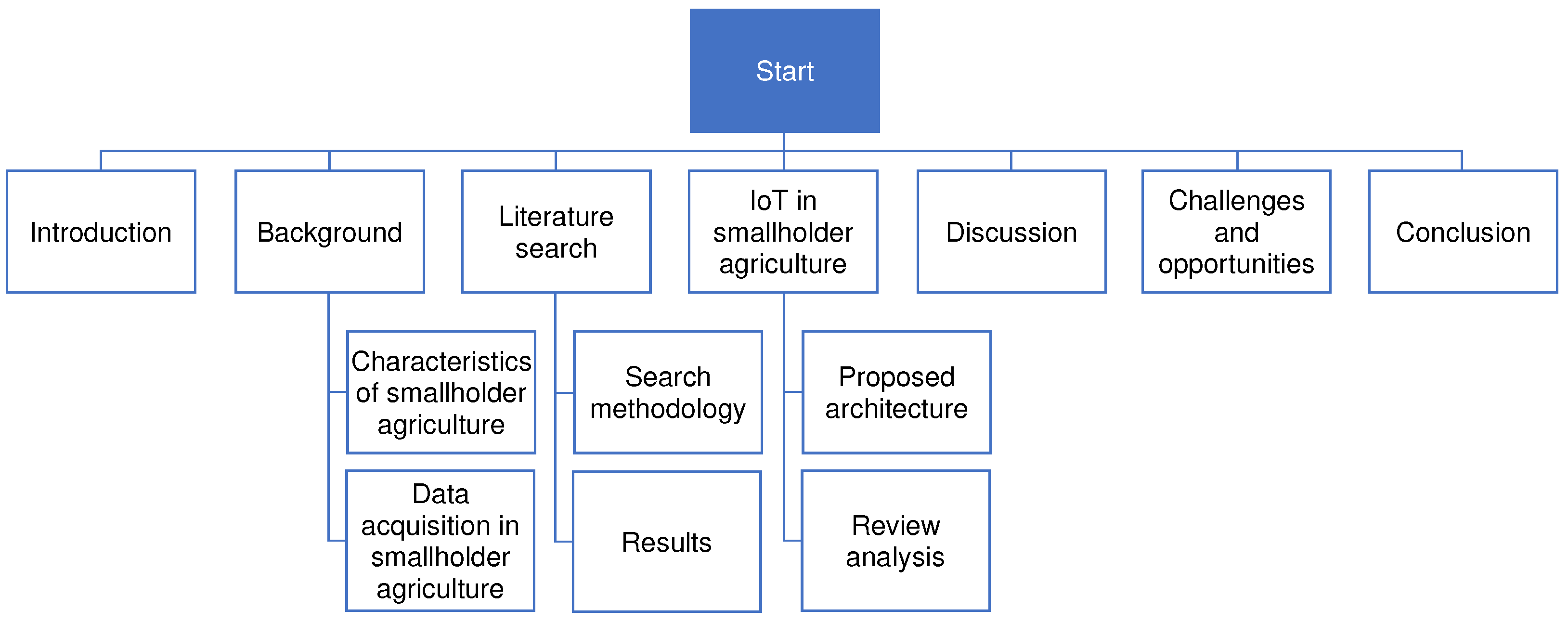
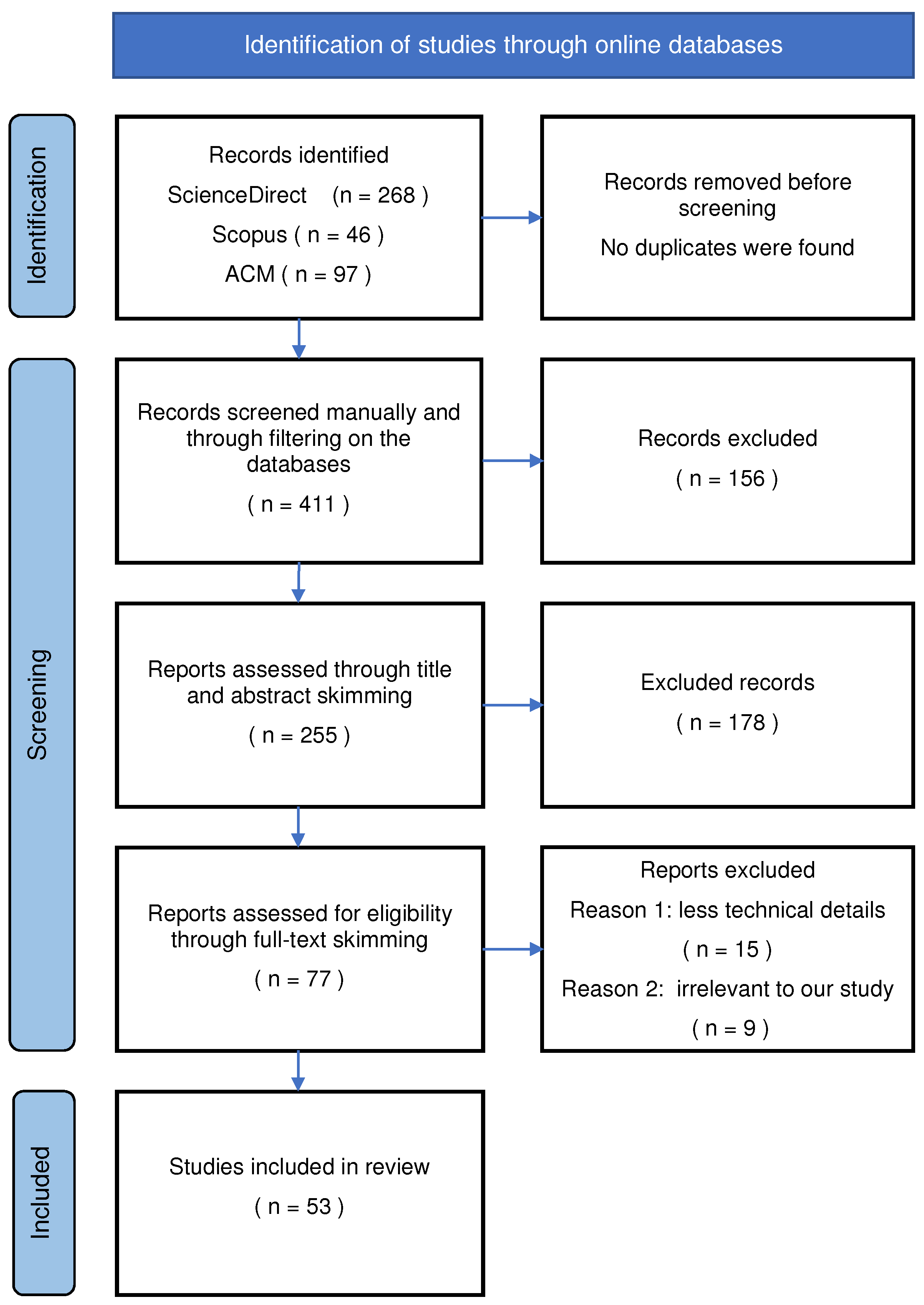
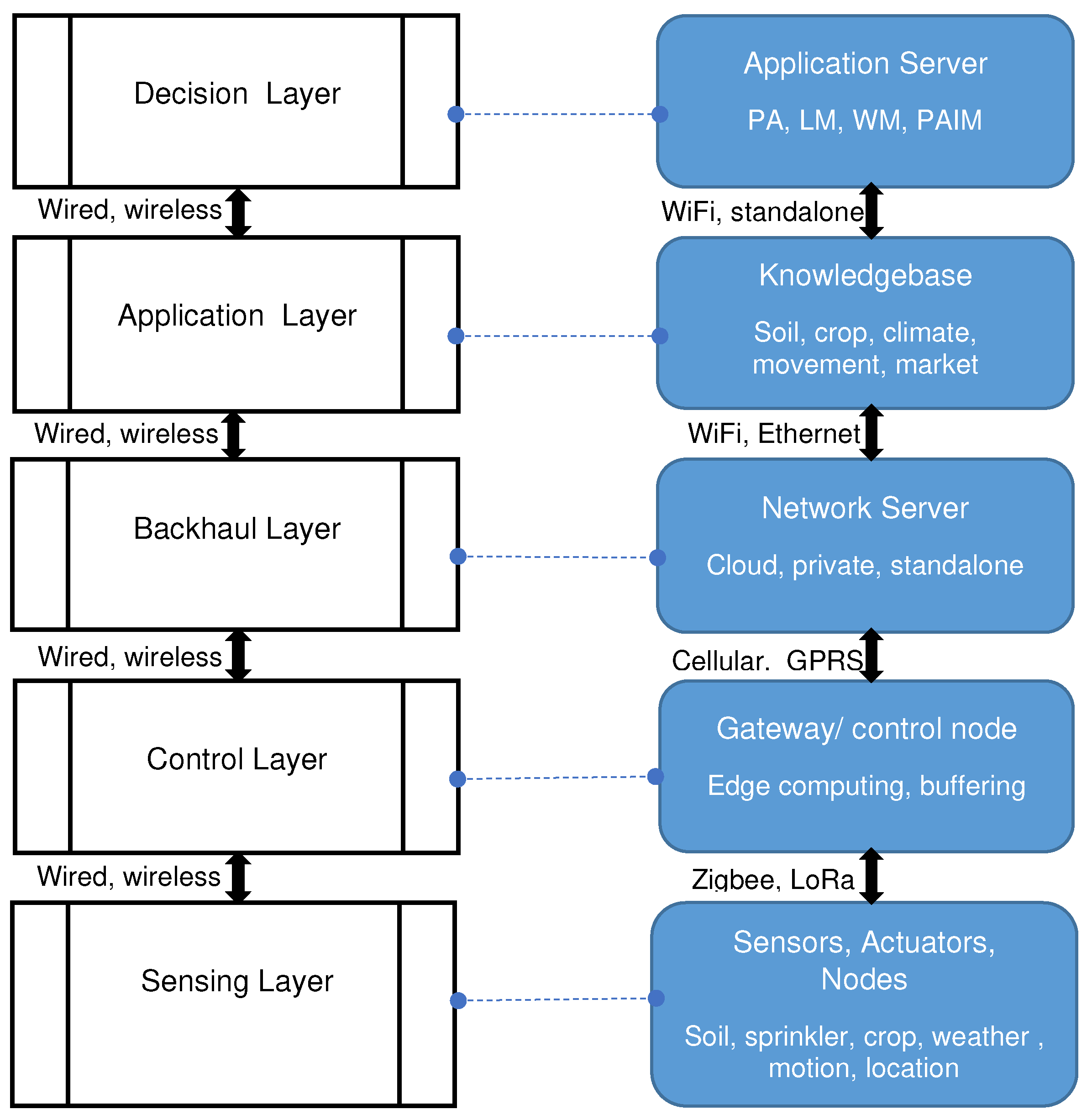

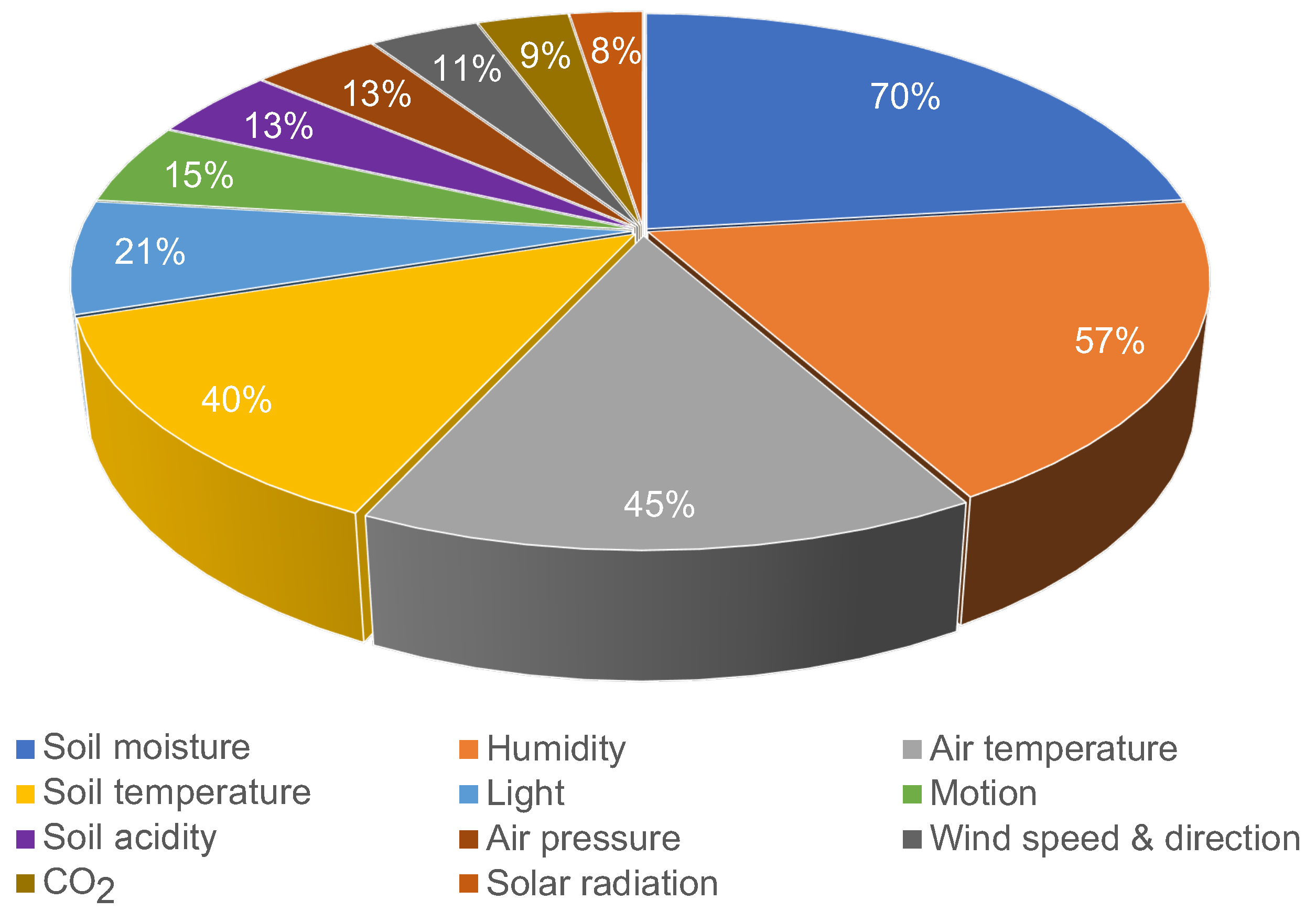
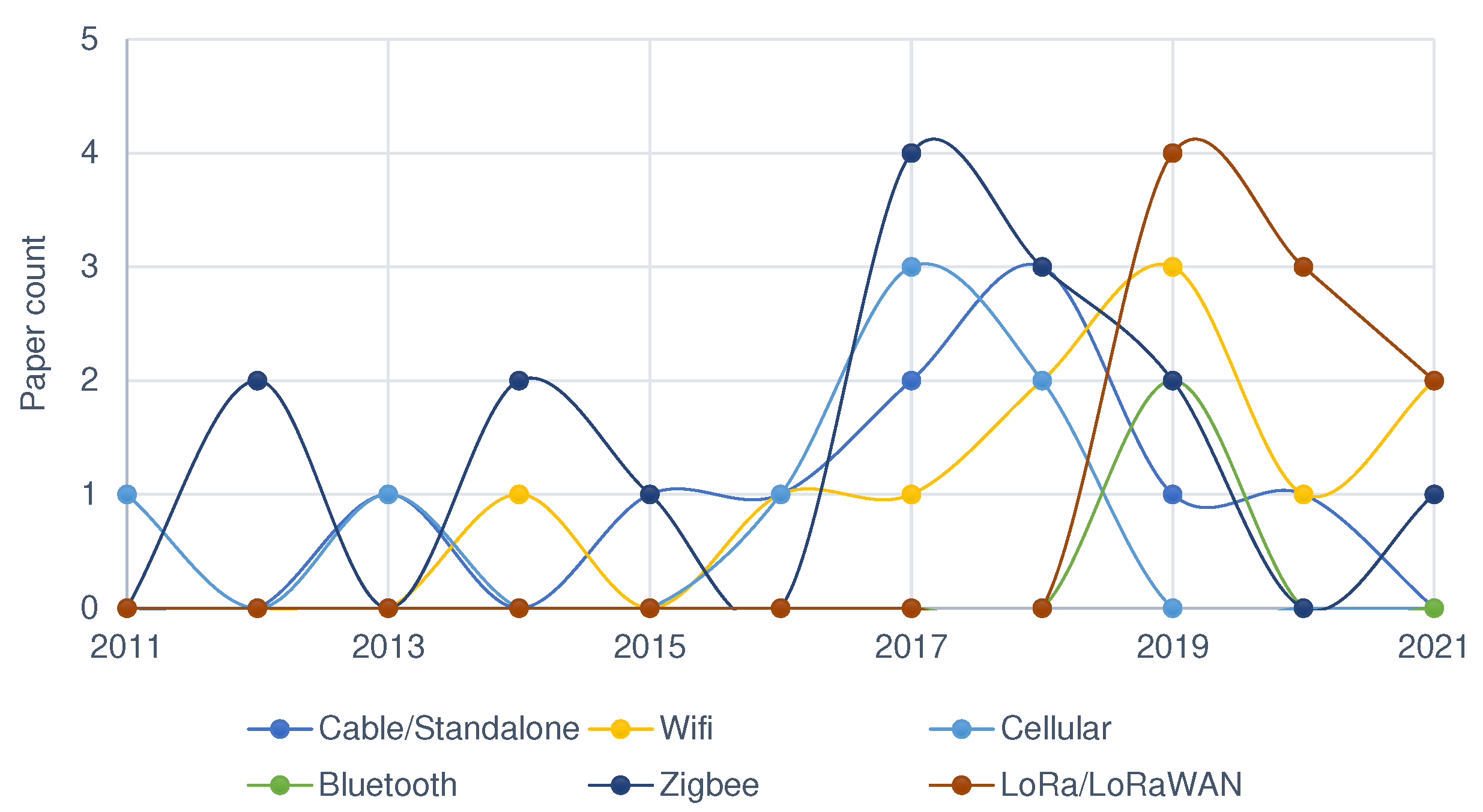
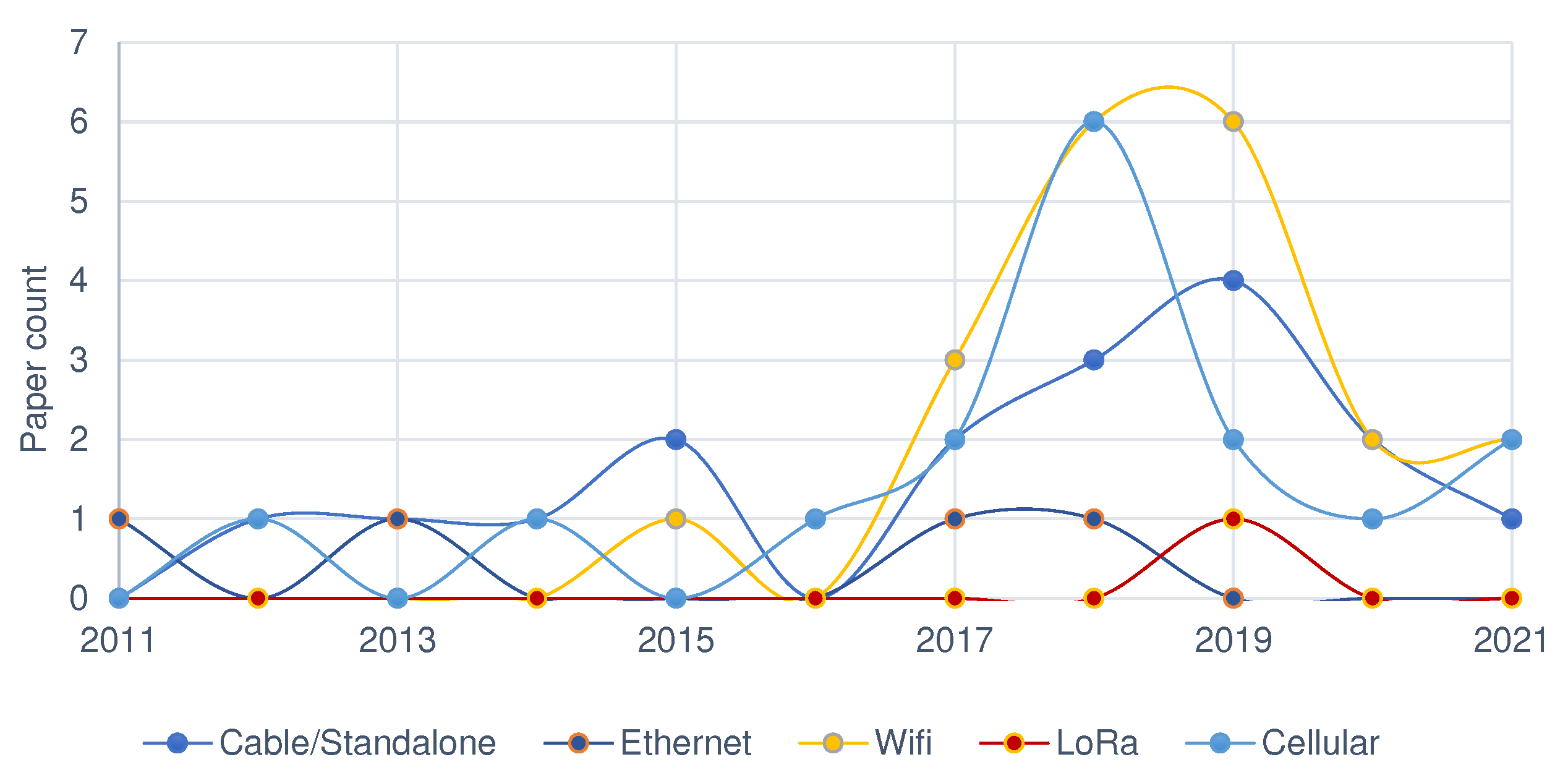
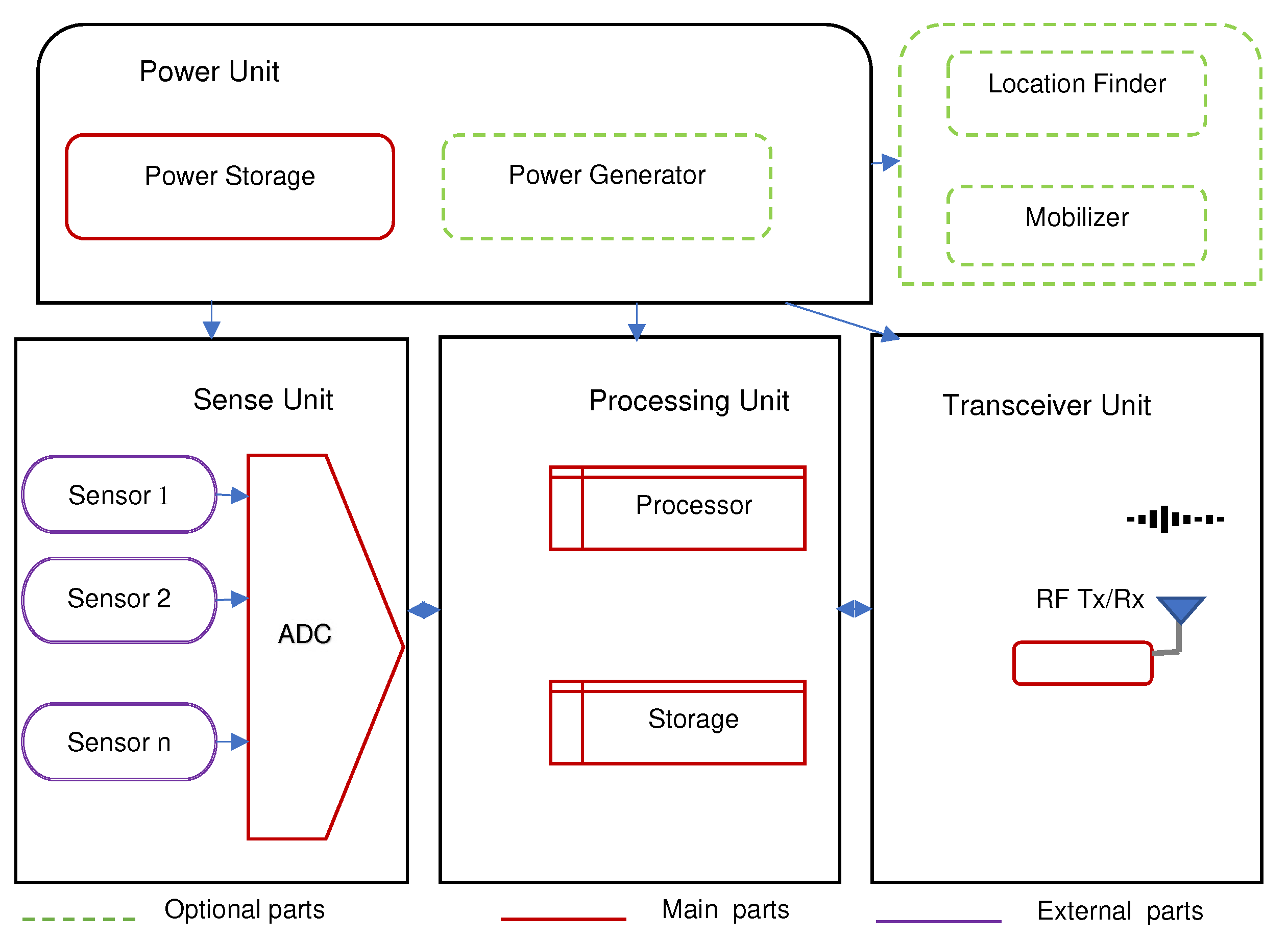
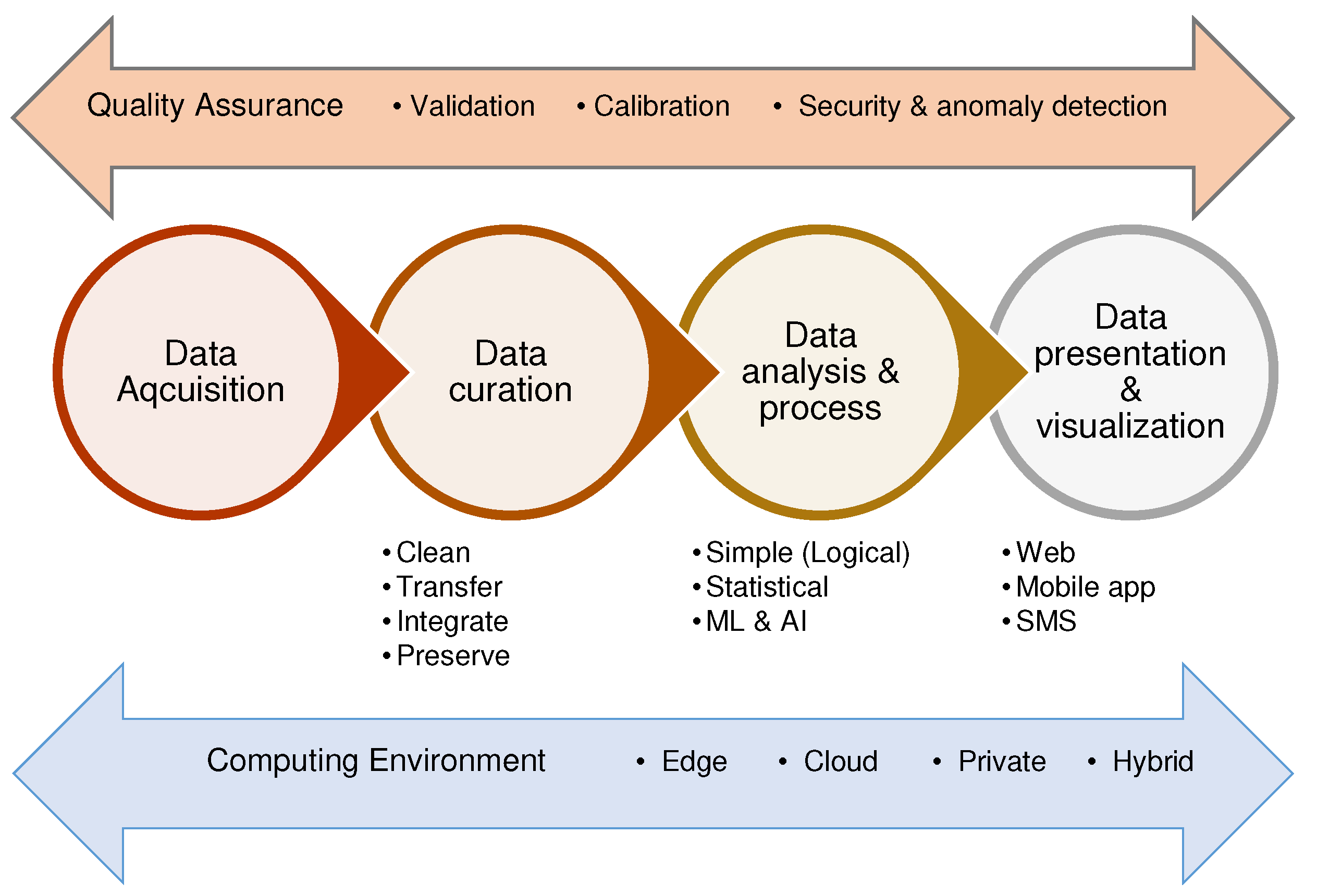

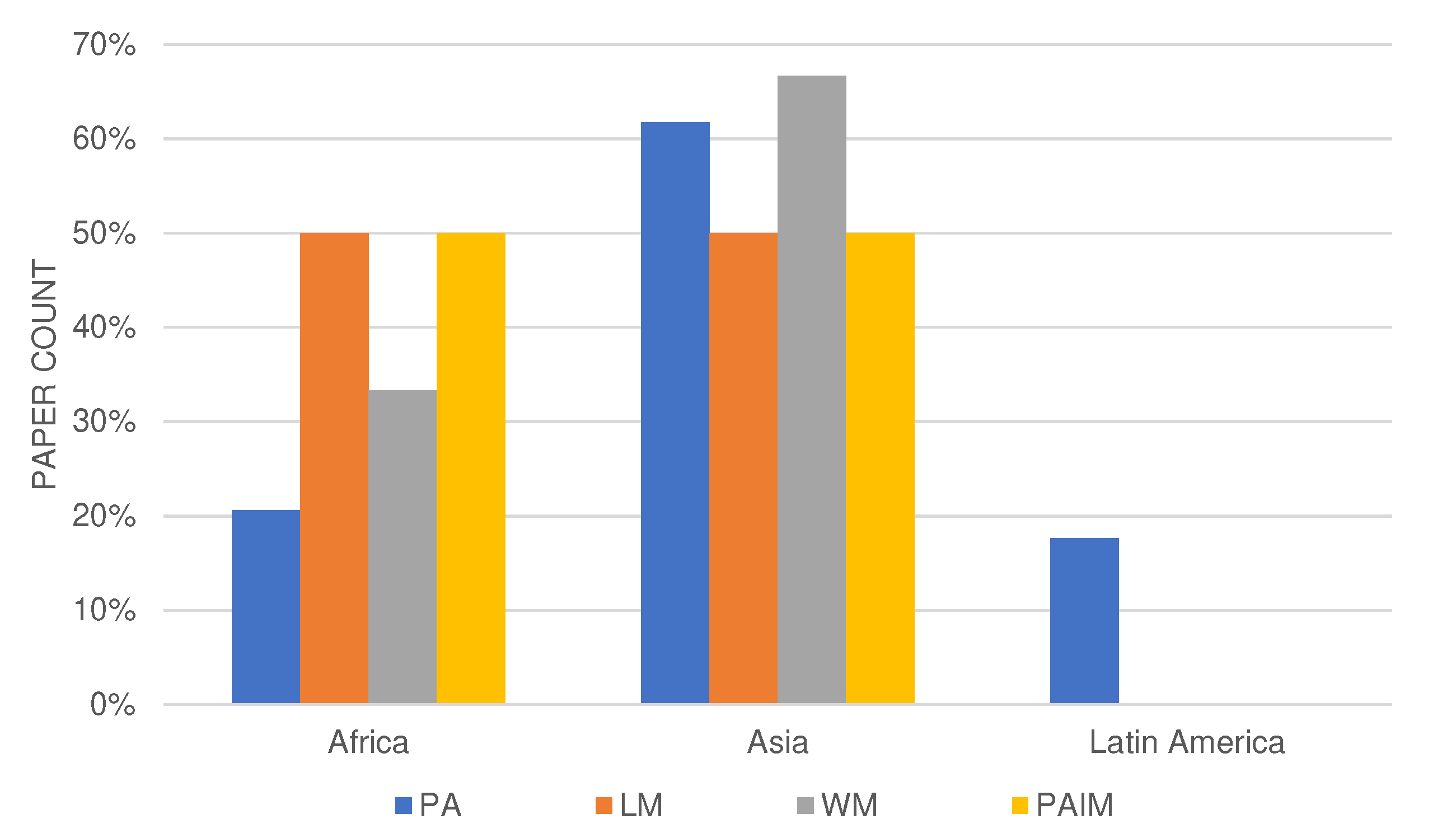
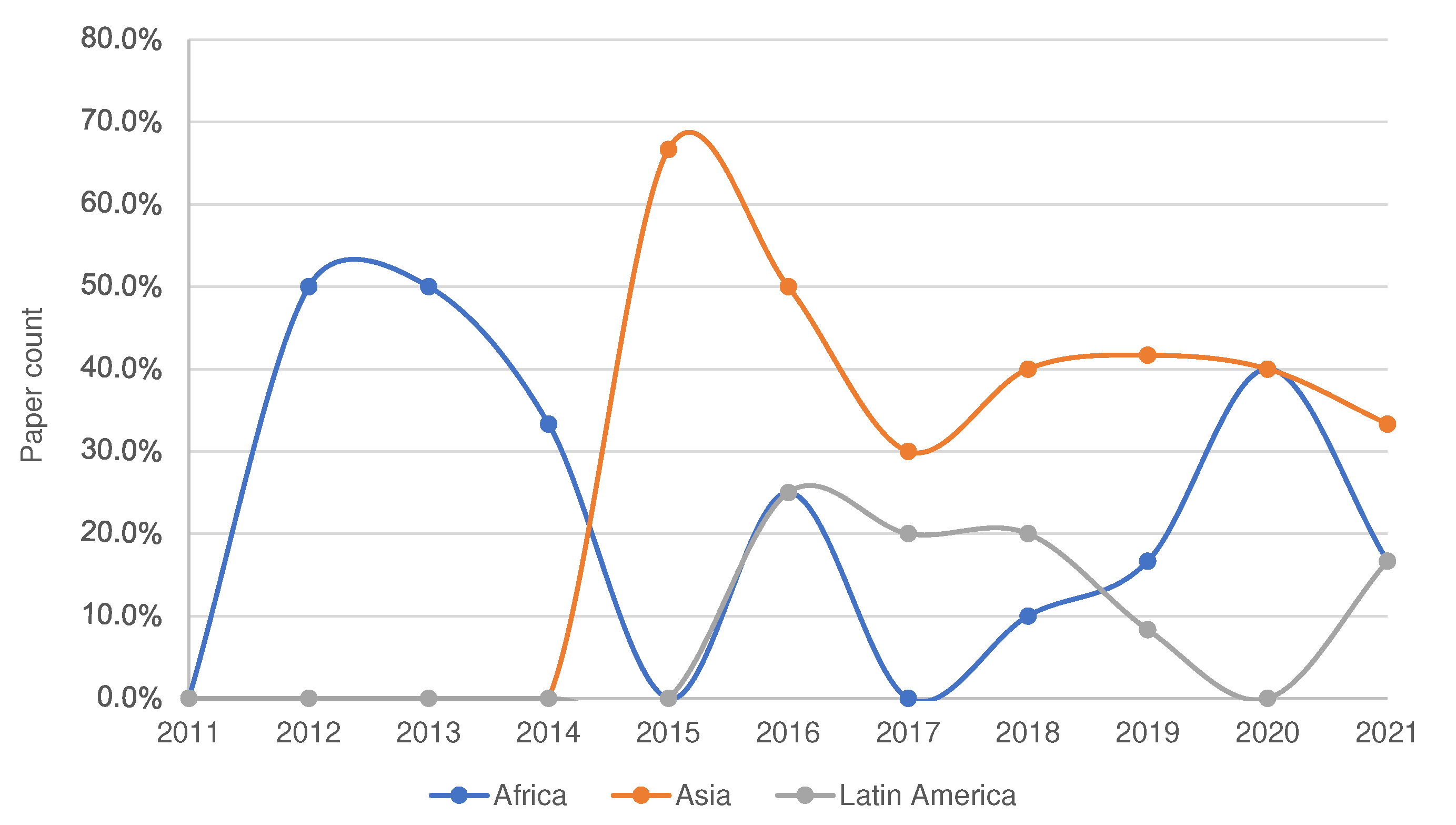
| Search Parameter | Value |
|---|---|
| Search query | Internet of Things (IoT) AND (Wireless Sensor Network (WSN) OR sensor) |
| AND small AND (agriculture OR farm *) AND “smart farming” | |
| Inclusion criteria | Open access |
| Research article, conference proceeding, book chapter, software or data publication | |
| Small farms or smallholder agriculture | |
| Wireless communication | |
| 2010–2021 | |
| Exclusion criteria | Targets mechanized, large-scale farms, developed countries |
| Non-English manuscripts | |
| Less technical details or mostly higher-level descriptions | |
| Theoretical frameworks | |
| Non-agricultural applications | |
| Citation databases | ACM |
| Scopus | |
| ScienceDirect |
| Wireless Technology | WiFi | WiMAX | ZigBee | Cellular | Bluetooth | LoRa |
|---|---|---|---|---|---|---|
| Wireless network | WLAN | WMAN | WPAN | WWAN | PAN | LPWAN |
| Standard | 802.11 * | 802.16 * | 802.15.4 * | 2/3/4 G | 802.15.1 * | LoRaWAN |
| Operating Frequency (Hz ) | 5–60 G | 2–6 G | 868/919 M | 2.4 G, 865 M | 2.4 G | 433/868/900 M |
| Data Rate (bps ) | 1 M–6.75 G | 1 M–1 G | 40–250 K | 50 K–1 G | 1–24 M | 0.3–50 K |
| Transmission Range | 20–100 m | <50 km | 10–20 m | Entire cellular | 8–10 m | <50 km |
| Power Consumption | High | Medium | Low | Medium | Medium | Very low |
| Cost | High | High | Low | Medium | Low | High |
| Operating Life | Years | Hours | Up to 2 years | Hours | Hours | 10–20 Years |
| Noise Resistance | Low | Medium | Medium | Medium | Low | High |
| References | [58,59,60,61,62,63,64,65,66,67,68,69,70] | [71,72] | [62,73,74,75,76,77,78,79,80,81,82,83] | [84,85,86,87,88,89,90,91,92,93,94] | [95,96,97,98,99] | [100,101,102,103,104,105,106] |
| Data Science Action | Techniques/Approaches |
|---|---|
| Data curation | Data preservation [61,64,74,75,84,85,89,102,105,111,115] |
| Data transfer to JSON and XML formats [75,89,93,102] | |
| Data fuzzification and de-fuzzification [62] | |
| Redundant data removal [61] | |
| Data analysis and processing | If then [60,64,68,69,85,91,93,99,104,111,115] |
| Statistical [61,80,87,88,89,100,105] | |
| ML and AI [62,63,65,76,92,94,103] | |
| Data presentation and visualization | Web-based [58,61,63,64,74,75,76,81,84,91,92,93,94,99,100,105,111,115,138,139] |
| App-based [62,68,69,85,100,102,104,105,139] | |
| SMS-based [60,85,87,92,104,115] | |
| Computing environment | Cloud [58,60,62,64,65,68,69,75,76,82,85,89,91,93,102,104,105,115,138,139] |
| Edge and/or Fog [61,99,103] | |
| Private server [74,81,84,87,94,100,111] | |
| Quality assurance measures | Non-elaborated calibration [84,93,106] |
| Data validation based on descriptive statistics [104] | |
| Reliability and data accuracy assessment based on ISO/IEC 9126 [83] | |
| Sensor calibration based on standard laboratory results [76] | |
| Sensor calibration using conventional weather station readings [94] | |
| Sensor data validation against standard laboratory results [82] | |
| Sensor data validation using linear correlation [65] | |
| Transaction validation based on block chain [62] |
| Micro-Controllers | Application Domain | |||
|---|---|---|---|---|
| PA | LM | WM | PAIM | |
| Arduino | [62,77,78,85,87,98,100] | [86,104] | [81] | |
| Atmega | [89,91,96,102] | [79] | [91,92] | |
| NodeMCU | [58,68] | [70] | [60,61] | |
| RPi | [63,64,84,101,139] | [83,105] | ||
| Others | [73,74,75,76,110,113] | [82,94] | ||
| Network | Communication Standard | Application Domain | |||
|---|---|---|---|---|---|
| PA | LM | PAIM | WM | ||
| WSN | Bluetooth | [95,96,97,98] | [99] | ||
| GPRS/GSM | [84,85] | [86] | |||
| LoRa/LoRaWAN | [100,101,102,103] | [104] | [105] | ||
| WiFi | [58,59,89,98] | [60,61] | [93] | ||
| Zigbee | [62,73,74,75,76,77,78,88,106] | [79,80] | [81] | [82,83] | |
| Wired | [63,64,65,68,96,113] | [92] | [70,94] | ||
| Backhaul | GPRS/GSM | [73,77,87,88,89,90,102] | [86,104] | [91,92] | [93,94] |
| LoRa | [106] | ||||
| WiFi | [58,62,63,64,65,66,67,68,69,85,89,97,98] | [60,61,99] | [70,82] | ||
| Ethernet/standalone | [74,78,84,95,96,100,103,110,113,139] | [79] | [81] | [83,105] | |
Publisher’s Note: MDPI stays neutral with regard to jurisdictional claims in published maps and institutional affiliations. |
© 2022 by the authors. Licensee MDPI, Basel, Switzerland. This article is an open access article distributed under the terms and conditions of the Creative Commons Attribution (CC BY) license (https://creativecommons.org/licenses/by/4.0/).
Share and Cite
Bayih, A.Z.; Morales, J.; Assabie, Y.; de By, R.A. Utilization of Internet of Things and Wireless Sensor Networks for Sustainable Smallholder Agriculture. Sensors 2022, 22, 3273. https://doi.org/10.3390/s22093273
Bayih AZ, Morales J, Assabie Y, de By RA. Utilization of Internet of Things and Wireless Sensor Networks for Sustainable Smallholder Agriculture. Sensors. 2022; 22(9):3273. https://doi.org/10.3390/s22093273
Chicago/Turabian StyleBayih, Amsale Zelalem, Javier Morales, Yaregal Assabie, and Rolf A. de By. 2022. "Utilization of Internet of Things and Wireless Sensor Networks for Sustainable Smallholder Agriculture" Sensors 22, no. 9: 3273. https://doi.org/10.3390/s22093273
APA StyleBayih, A. Z., Morales, J., Assabie, Y., & de By, R. A. (2022). Utilization of Internet of Things and Wireless Sensor Networks for Sustainable Smallholder Agriculture. Sensors, 22(9), 3273. https://doi.org/10.3390/s22093273






